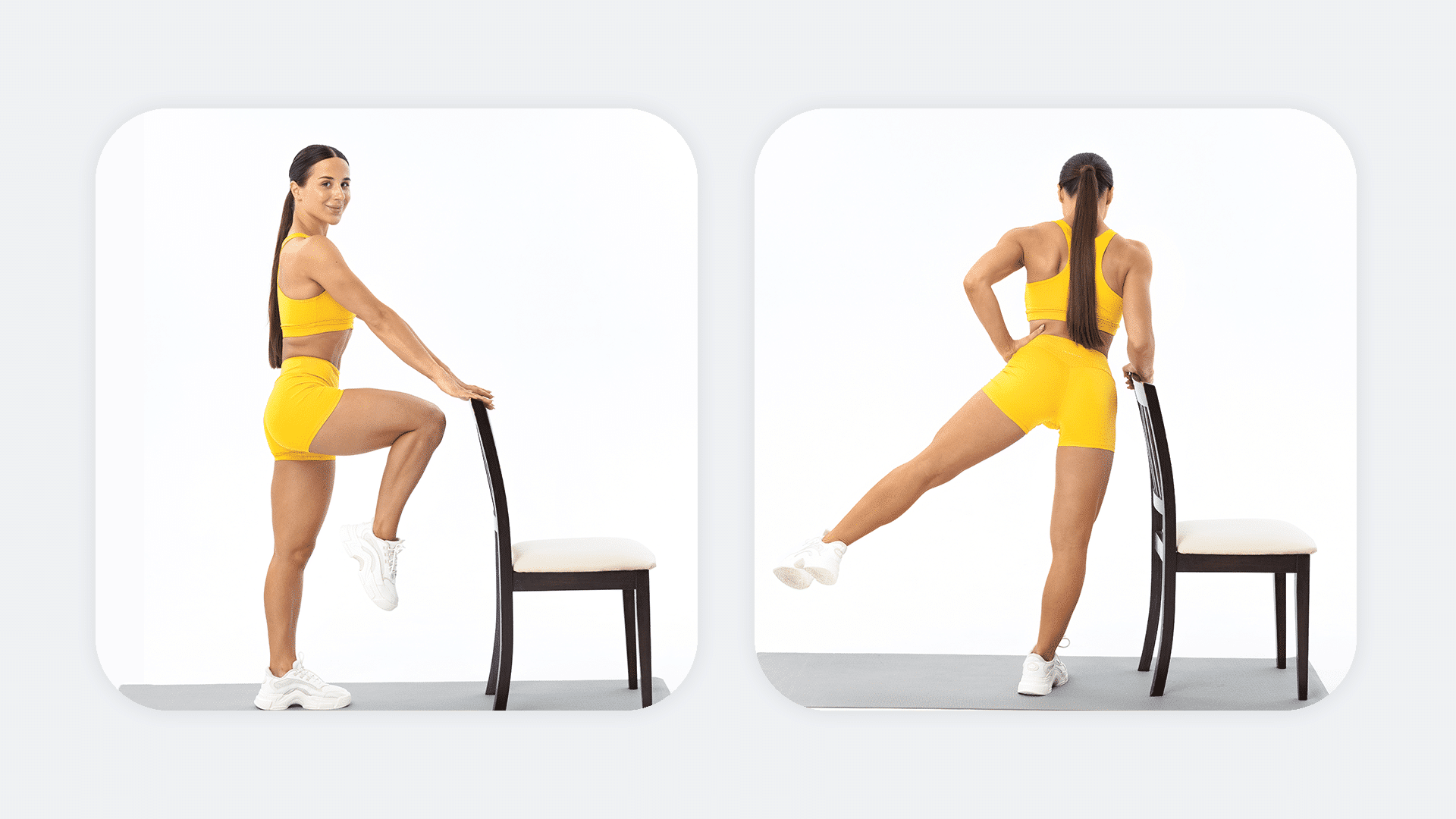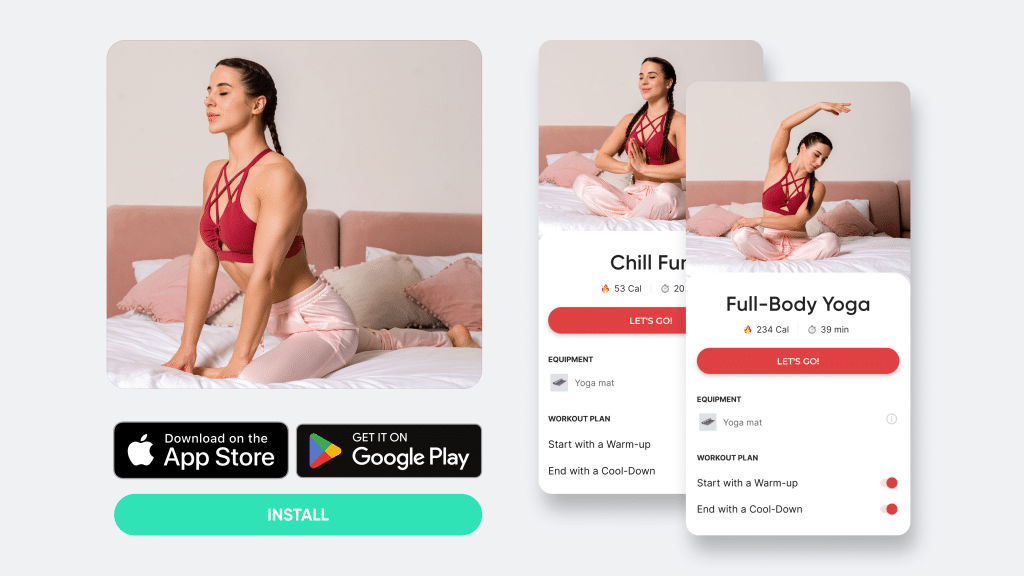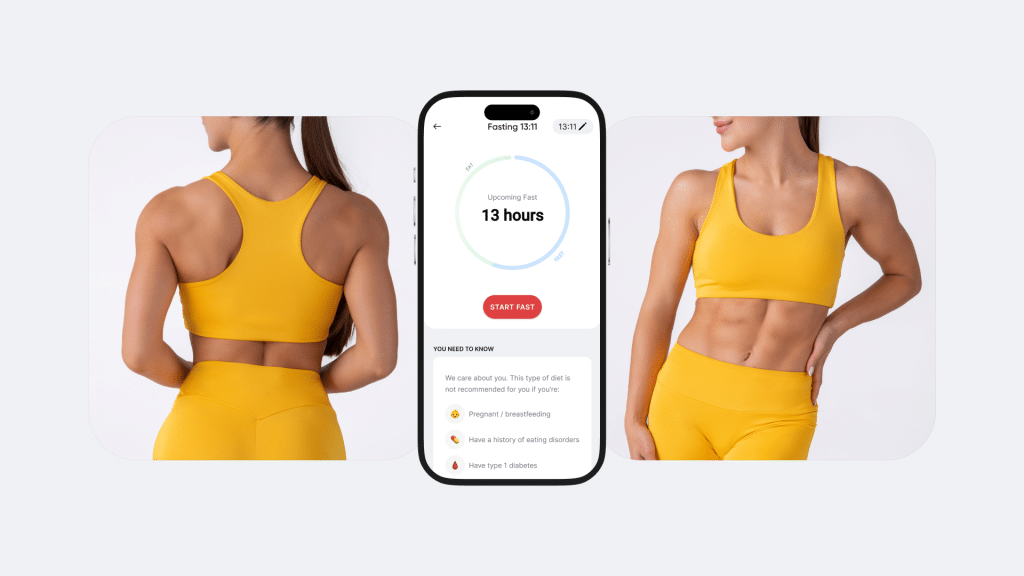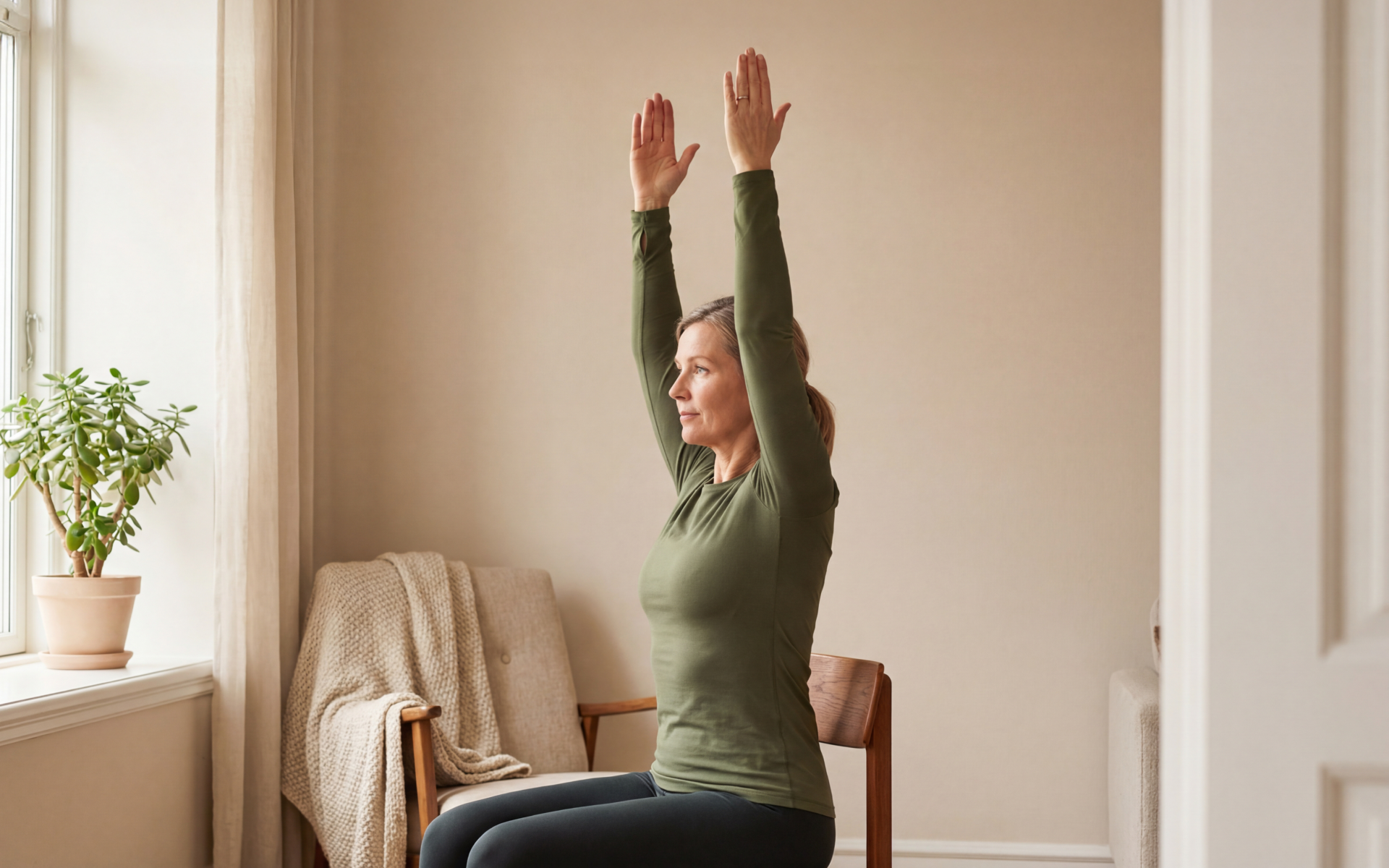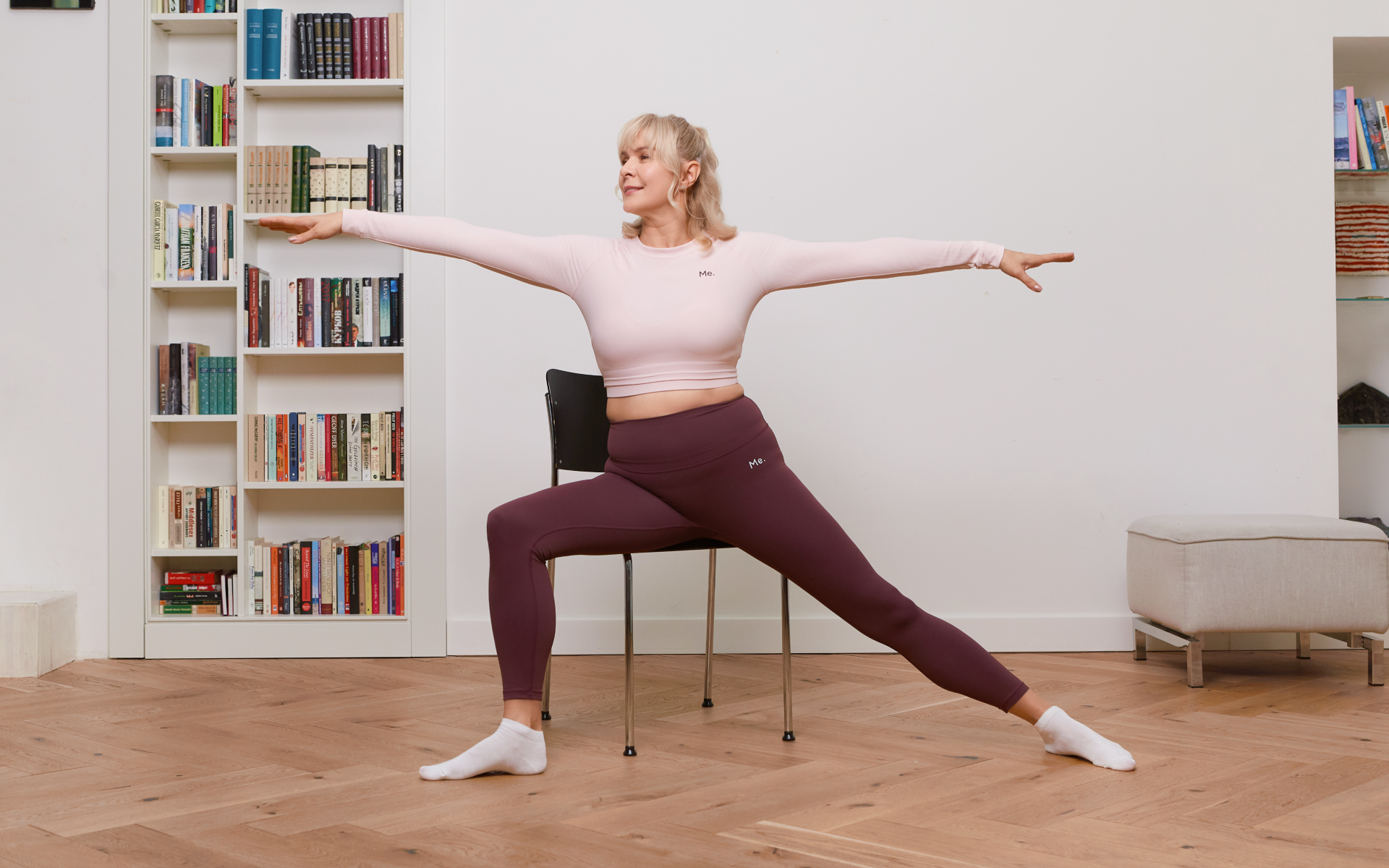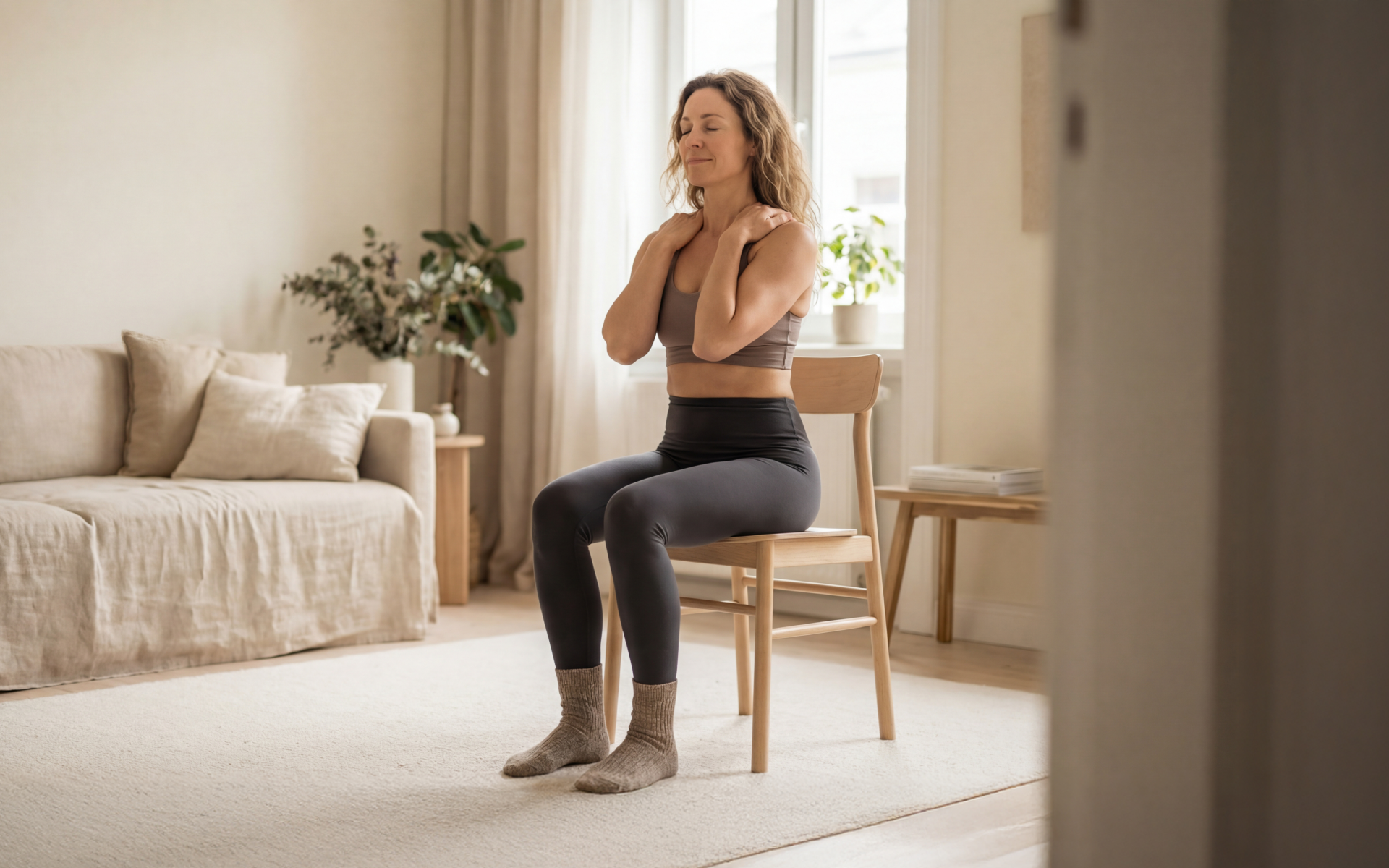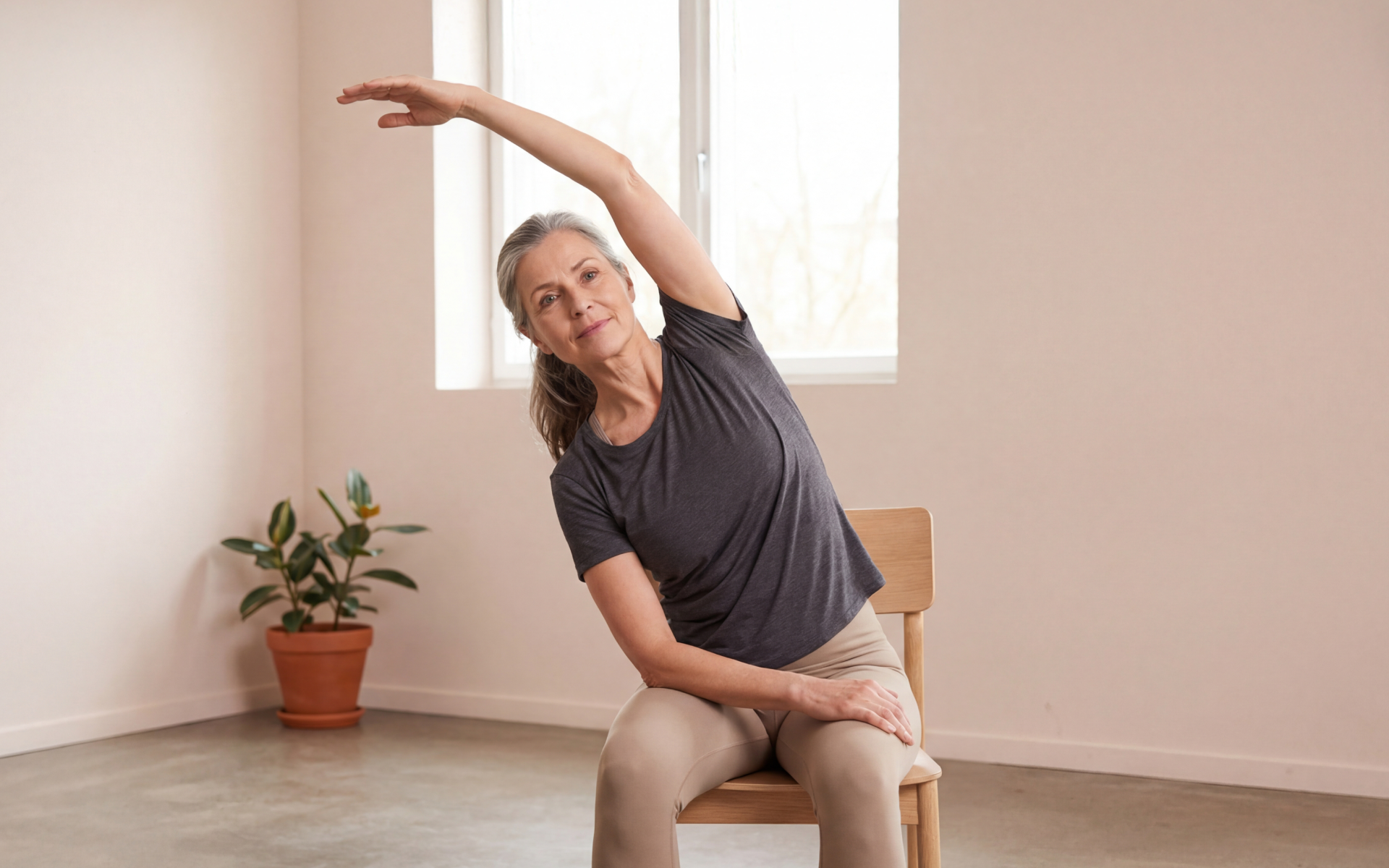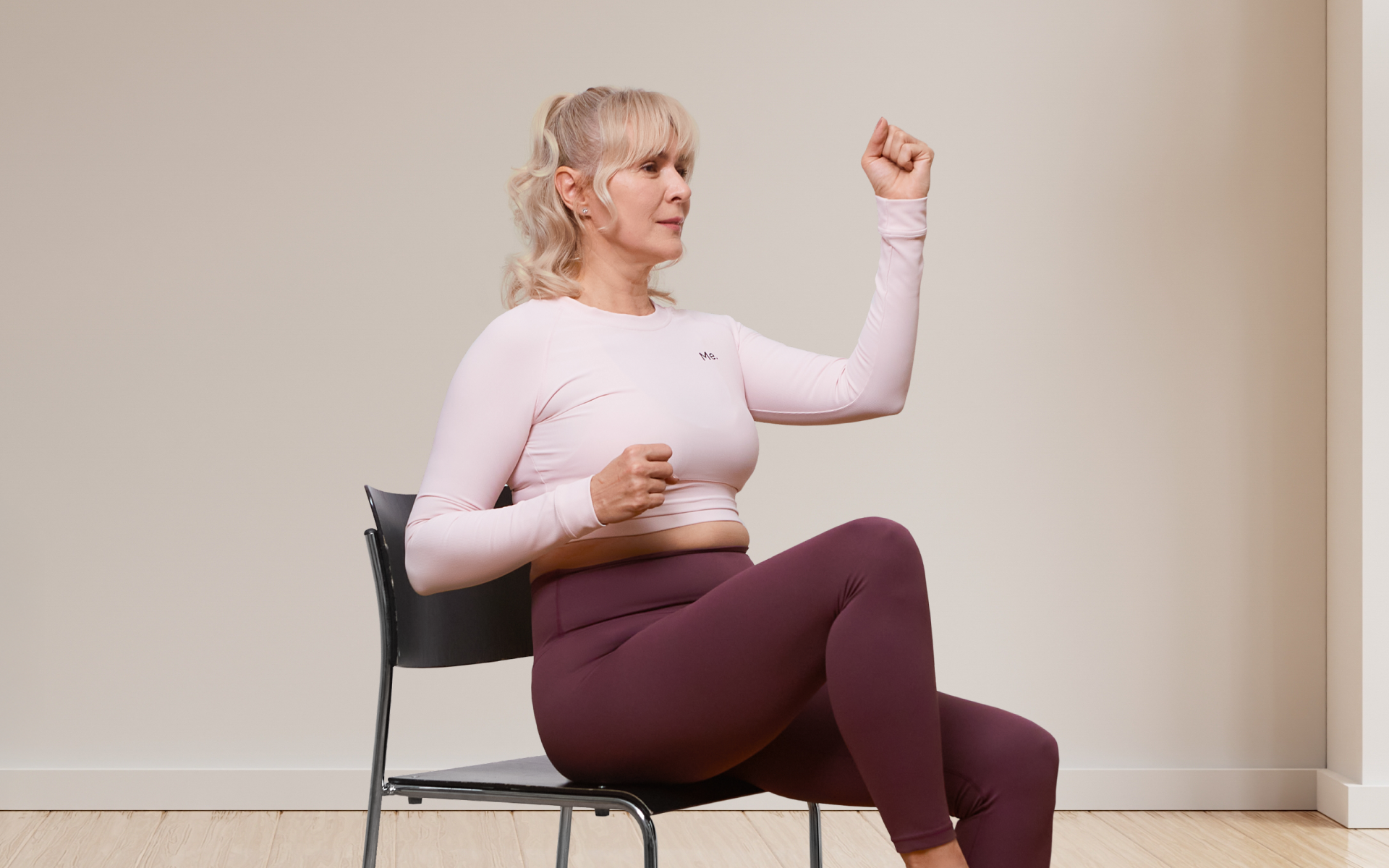You’ve had a long day at work, and your body is craving some much-needed stretching and relaxation. But the thought of contorting yourself into a pretzel-like yoga pose is enough to make you look for a game to play. There’s a solution to your dilemma, and it is chair yoga! This low-impact approach to exercise offers a lot of benefits, from improved flexibility to reduced stress, without the need to impersonate an Olympic gymnast. In this guide, we’ll delve into the magic of various chair yoga poses, each suited for different moments and needs, ensuring that you’ll become a master of this zen-inducing practice in no time. Grab a chair, take a seat (literally), and let’s embark on this journey towards a more balanced, bendy, and blissful you.
What Is Chair Pose Yoga?
Chair Yoga is an innovative and inclusive adaptation of traditional yoga, specifically designed to cater to individuals with mobility challenges or physical limitations.
The primary distinction between Chair Yoga and conventional yoga lies in the use of a chair as a supportive prop, allowing practitioners to perform modified versions of classic poses while seated or using the chair for balance and stability.
Chair Yoga is an excellent option for a diverse range of populations who may benefit from this accessible and gentle practice. These include:
Seniors:
As we age, our flexibility, balance, and muscle strength tend to decrease. Chair Yoga provides a safe and gentle way for seniors to maintain or improve their physical fitness while minimizing the risk of injury (2).
Individuals With Disabilities:
For people with disabilities that impact their mobility or balance, Chair Yoga offers an adaptable practice tailored to suit their unique needs, making yoga accessible and enjoyable.
Office Workers:
Long hours of sitting at a desk can lead to poor posture, muscle tension, and stress (1). Chair Yoga serves as a convenient and effective way for office workers to incorporate movement and relaxation into their daily routines without leaving their workspace.
Read More: Regain Flexibility And Build Strength With Guided 28-Day Chair Yoga For Seniors
Individuals Recovering From Injury:
During the recovery process, it’s essential to maintain a level of physical activity that doesn’t exacerbate the injury. Chair Yoga allows for a gentler practice that can support rehabilitation while promoting overall well-being.
Pregnant Women:
Pregnancy can bring about various physical discomforts and limitations. Chair Yoga offers a safe and supportive way for expectant mothers to continue their yoga practice, ensuring both physical and mental benefits throughout pregnancy.
Beginners Or Those With Limited Flexibility:
For individuals new to yoga or those with restricted flexibility, chair Yoga can serve as a helpful stepping stone towards building confidence, strength, and flexibility before transitioning to more traditional yoga practices.
Different Yoga Pose Variations For Different Needs
Chair Yoga poses are often modified versions of classic yoga poses, making them more accessible to practitioners of all levels and abilities. But which yoga pose variations are best for different situations?
Here’s a breakdown of the most popular Chair Yoga poses and when to use them:
Scenario 1: Tight Hips From Sitting All Day
Pose 1: Seated Pigeon Pose (Eka Pada Rajakapotasana)
- Sit on the edge of your chair with your feet flat on the floor, hip-width apart.
- Lift your right ankle and place it on top of your left knee, allowing your right knee to open out to the side.
- Keep your spine straight and gently hinge forward from your hips until you feel a stretch in your right hip and glutes.
- Hold this pose for 5-10 breaths, then switch sides and repeat.
Pose 2: Seated Cow Face Pose (Gomukhasana)
- Sit on the edge of your chair with your feet flat on the floor, hip-width apart.
- Cross your right thigh over your left thigh, stacking your knees as closely as possible.
- Bring your right foot to the outside of your left hip and your left foot to the outside of your right hip.
- Sit up tall, lengthening your spine, and rest your hands on your knees.
- Hold this pose for 5-10 breaths, then switch sides and repeat.
Scenario 2: Bloating After Lunch
Pose 1: Seated Twist (Ardha Matsyendrasana)
- Sit on the edge of your chair with your feet flat on the floor, hip-width apart.
- Place your right hand on your left knee and your left hand on the back of your chair.
- Lengthen your spine and gently twist to the left, using your hands to deepen the twist.
- Hold this pose for 5-10 breaths, then switch sides and repeat.
Pose 2: Seated Cat-Cow Stretch
- Sit on the edge of your chair with your feet flat on the floor, hip-width apart.
- Place your hands on your knees and engage your core muscles.
- Inhale and arch your back, lifting your chest and gaze upward for Cow Pose.
- Exhale and round your spine, tucking your chin toward your chest for Cat Pose.
- Continue to alternate between these poses for 5-10 breaths.
Scenario 3: Upper Back And Shoulder Tension
Pose 1: Seated Eagle Arms (Garudasana Arms)
- Sit on the edge of your chair with your feet flat on the floor, hip-width apart.
- Extend your arms out in front of you and cross your right arm over your left, bending your elbows.
- Bring your palms together or place the back of your hands together.
- Lift your elbows while keeping your shoulders relaxed, feeling a stretch in your upper back and shoulders.
- Hold this pose for 5-10 breaths, then switch sides and repeat.
Pose 2: Seated Shoulder Opener
- Sit on the edge of your chair with your feet flat on the floor, hip-width apart.
- Interlace your fingers behind your back, straightening your arms as much as possible.
- Gently lift your hands away from your lower back, opening your chest and feeling a stretch in your shoulders and chest.
- Hold this pose for 5-10 breaths, then release.
If you tend to let yourself off the hook, raise the white flag when things get tougher than you expected, send yourself on an unconscious binge-eating trip – BetterMe app is here to help you leave all of these sabotaging habits in the past!
Scenario 4: Stiff Neck And Tight Shoulders
Pose 1: Seated Neck Stretch
- Sit on the edge of your chair with your feet flat on the floor, hip-width apart.
- Place your right hand on top of your head, gently guiding your right ear towards your right shoulder.
- Keep your left shoulder relaxed and away from your ear, feeling a stretch along the left side of your neck.
- Hold this pose for 5-10 breaths, then switch sides and repeat.
Pose 2: Seated Shoulder Roll
- Sit on the edge of your chair with your feet flat on the floor, hip-width apart.
- Inhale and lift your shoulders up towards your ears.
- Exhale and roll your shoulders back and down, squeezing your shoulder blades together.
- Continue this rolling movement for 5-10 breaths, then reverse the direction for another 5-10 breaths.
Scenario 5: Lower Back Pain Or Discomfort
Pose 1: Seated Forward Bend (Paschimottanasana)
- Sit on the edge of your chair with your feet flat on the floor, hip-width apart.
- Lengthen your spine and hinge forward from your hips, keeping your back straight.
- Reach for your shins, ankles, or feet, depending on your flexibility.
- Allow your head to relax and feel a gentle stretch in your lower back and hamstrings.
- Hold this pose for 5-10 breaths, then slowly return to an upright position.
Pose 2: Seated Spinal Twist
- Sit on the edge of your chair with your feet flat on the floor, hip-width apart.
- Cross your right leg over your left, placing your right foot on the outside of your left knee.
- Place your left hand on your right knee and your right hand on the back of your chair.
- Inhale and lengthen your spine, then exhale and twist to the right, using your hands for support.
- Hold this pose for 5-10 breaths, then switch sides and repeat.
Scenario 6: Stress And Anxiety Relief
Pose 1: Seated Mountain Pose (Tadasana)
- Sit on the edge of your chair with your feet flat on the floor, hip-width apart.
- Rest your hands on your thighs, palms facing down, and close your eyes.
- Lengthen your spine, relax your shoulders, and engage your core muscles.
- Focus on slow, deep breaths, inhaling through your nose and exhaling through your mouth.
- Hold this pose for 5-10 breaths or as long as needed to feel calm and centered.
Pose 2: Seated Side Bend
- Sit on the edge of your chair with your feet flat on the floor, hip-width apart.
- Extend your arms overhead, interlacing your fingers and pointing your index fingers upward.
- Inhale and lengthen your spine, then exhale and bend to the right, feeling a stretch along the left side of your torso.
- Hold this pose for 5-10 breaths, then switch sides and repeat.
Scenario 7: Mental Fatigue And Lack Of Focus
Pose 1: Seated Breath of Fire (Kapalabhati Pranayama)
- Sit on the edge of your chair with your feet flat on the floor, hip-width apart.
- Rest your hands on your thighs, palms facing up, and close your eyes.
- Take a deep breath in through your nose, then exhale forcefully through your nose, pulling your lower belly in towards your spine.
- Continue this rapid breathing technique for 30-60 seconds, focusing on the exhale while allowing the inhale to happen naturally.
- After completing the Breath of Fire, take a few slow, deep breaths to normalize your breathing and enhance mental clarity.
Pose 2: Seated Alternate Nostril Breathing (Nadi Shodhana Pranayama)
- Sit on the edge of your chair with your feet flat on the floor, hip-width apart.
- Close your eyes and rest your left hand on your left thigh.
- Bring your right hand to your nose, placing your thumb against your right nostril and your ring finger against your left nostril.
- Close your right nostril with your thumb and inhale through your left nostril.
- Close your left nostril with your ring finger, release your thumb, and exhale through your right nostril.
- Inhale through your right nostril, then switch and exhale through your left nostril.
- Continue this alternating pattern for 5-10 rounds, promoting balance and focus.
Scenario 8: Difficulty Falling Asleep
Pose 1: Seated Legs-Up-the-Chair Pose (Viparita Karani Variation)
- Sit sideways on your chair, with your right hip touching the chair seat.
- Gently lower your upper body down to the floor as you swing your legs up onto the chair seat.
- Adjust your position so that your hips are as close to the chair as possible and your legs are supported by the chair seat.
- Place your arms by your sides, palms facing up, and close your eyes.
- Focus on slow, deep breaths and relax your body, holding this pose for 5-10 minutes or until you feel calm and ready for sleep.
Pose 2: Seated Forward Fold with Head Support (Paschimottanasana Variation)
- Sit on the edge of your chair with your feet flat on the floor, hip-width apart.
- Place a pillow or folded blanket on your thighs.
- Lengthen your spine and gently hinge forward from your hips, allowing your head to rest on the pillow or blanket.
- Let your arms hang loosely by your sides or rest them on the floor.
- Close your eyes and take slow, deep breaths, holding this pose for 5-10 minutes or until you feel relaxed and ready for sleep.
Read More: 20 Chair Yoga Exercises That’ll Take You From Couch Potato To Future Yogi
When Is The Best Time For Chair Pose Yoga?
The best time for Chair Pose Yoga, much like any other form of yoga, is subjective and depends on your personal preferences and daily schedule.
However, some popular times to practice Chair Pose Yoga include:
Morning:
Practicing Chair Yoga in the morning can be an excellent way to gently wake up your body and mind, setting a positive tone for the day ahead. It can also help increase energy levels and improve focus for the tasks you’ll be facing throughout the day.
Midday Or During Work Breaks:
Incorporating Chair Yoga into your lunch break or during short work breaks can help alleviate tension and stress accumulated from sitting at a desk for extended periods.
This practice can also re-energize your body and mind, enhancing productivity and mental clarity for the remainder of the day.
Evening:
Engaging in Chair Yoga in the evening can help you unwind after a long day, release physical tension, and calm your mind.
This practice can be particularly beneficial for individuals who have difficulty falling asleep, as it promotes relaxation and can prepare your body for a restful night’s sleep.
Ultimately, the best time for Chair Pose Yoga is when it seamlessly fits into your routine and allows you to fully enjoy its benefits. Consistency is key, so choose a time that works best for you and commit to practicing regularly for optimal results.
BetterMe app is a foolproof way to go from zero to a weight loss hero in a safe and sustainable way! What are you waiting for? Start transforming your body now!
The Bottom Line
Chair Yoga is an accessible, gentle, and effective form of yoga that caters to a wide range of individuals, regardless of age, physical abilities, or experience level.
By incorporating a chair as a supportive prop, it allows practitioners to experience the numerous benefits of traditional yoga in a safe, comfortable, and inclusive environment.
Try the targeted poses, such as those for tight hips, bloating, upper back tension, lower back pain, stress, anxiety, mental fatigue, and sleep difficulties, and see how Chair Yoga can help you feel your best.
DISCLAIMER:
This article is intended for general informational purposes only and does not serve to address individual circumstances. It is not a substitute for professional advice or help and should not be relied on for making any kind of decision-making. Any action taken as a direct or indirect result of the information in this article is entirely at your own risk and is your sole responsibility.
BetterMe, its content staff, and its medical advisors accept no responsibility for inaccuracies, errors, misstatements, inconsistencies, or omissions and specifically disclaim any liability, loss or risk, personal, professional or otherwise, which may be incurred as a consequence, directly or indirectly, of the use and/or application of any content.
You should always seek the advice of your physician or other qualified health provider with any questions you may have regarding a medical condition or your specific situation. Never disregard professional medical advice or delay seeking it because of BetterMe content. If you suspect or think you may have a medical emergency, call your doctor.
SOURCES:
- Ergonomics for Prolonged Sitting (n.d., uclahealth.org)
- Safety and feasibility of modified chair-yoga on functional outcome among elderly at risk for falls (2012, nih.gov)
